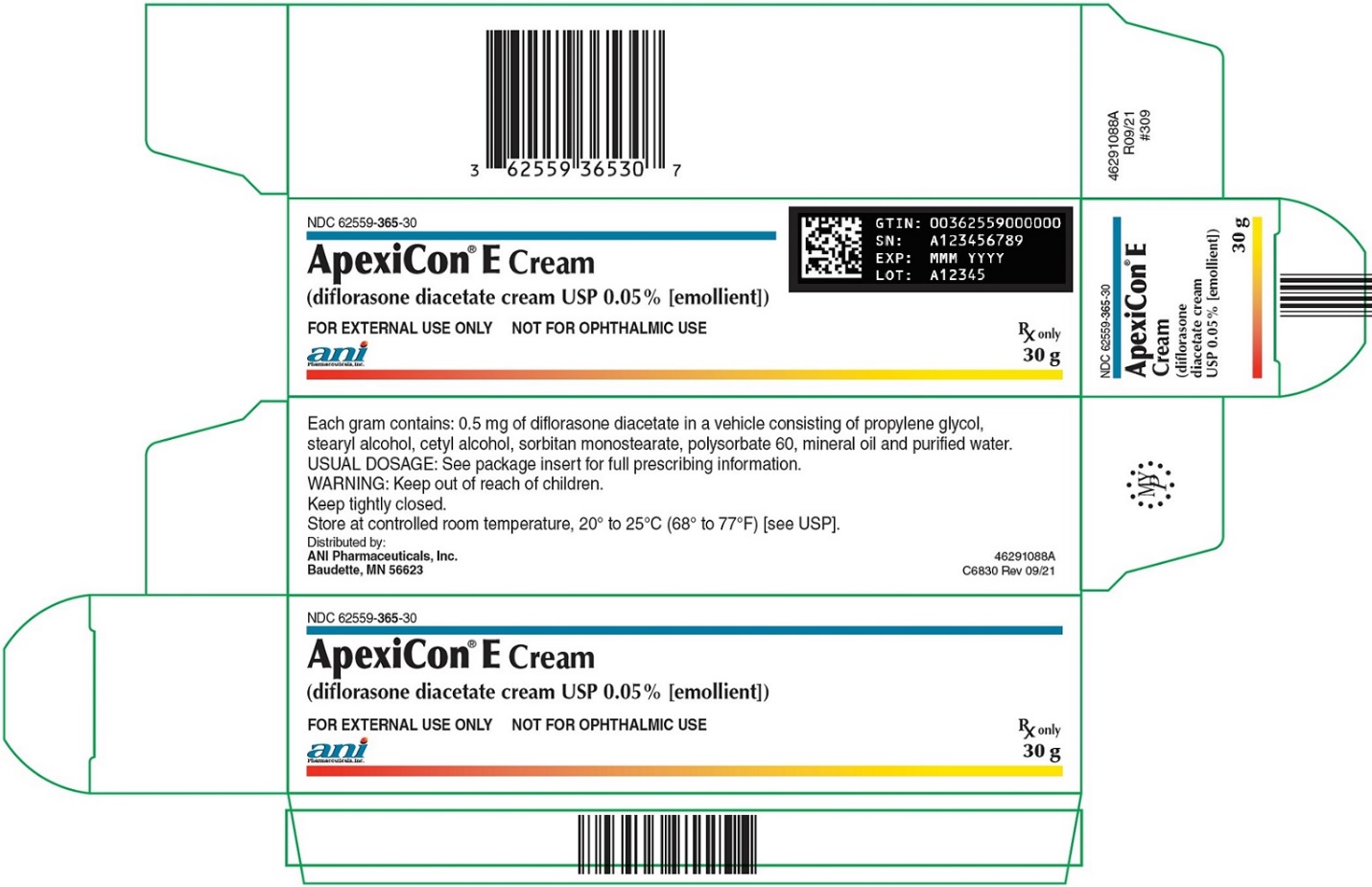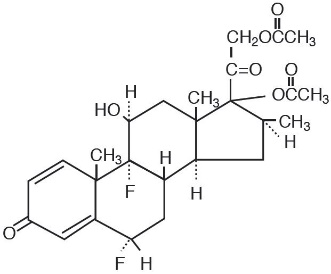Label: APEXICON E- diflorasone diacetate cream
- NDC Code(s): 62559-365-26, 62559-365-30, 62559-365-60
- Packager: ANI Pharmaceuticals, Inc.
- Category: HUMAN PRESCRIPTION DRUG LABEL
- DEA Schedule: None
- Marketing Status: Abbreviated New Drug Application
Drug Label Information
Updated November 15, 2024
If you are a consumer or patient please visit this version.
- Download DRUG LABEL INFO: PDF XML
- Official Label (Printer Friendly)
-
DESCRIPTION
Each gram of ApexiCon® E Cream (diflorasone diacetate cream USP, 0.05% [emollient]) contains 0.5 mg diflorasone diacetate in a cream base for topical dermatological use.
Chemically, diflorasone diacetate is: 6α,9-difluoro-11β,17,21-trihydroxy-16β-methylpregna-1,4-diene-3,20-dione 17,21-diacetate.
The structural formula is represented below:
Each gram of ApexiCon® E Cream (diflorasone diacetate cream USP, 0.05% [emollient]) contains: 0.5 mg diflorasone diacetate in a hydrophilic vanishing cream base of propylene glycol, stearyl alcohol, cetyl alcohol, sorbitan monostearate, polysorbate 60, mineral oil and purified water.
-
CLINICAL PHARMACOLOGY
Topical corticosteroids share anti-inflammatory, antipruritic and vasoconstrictive actions.
The mechanism of anti-inflammatory activity of the topical corticosteroids is unclear. Various laboratory methods, including vasoconstrictor assays, are used to compare and predict potencies and/or clinical efficacies of the topical corticosteroids. There is some evidence to suggest that a recognizable correlation exists between vasoconstrictor potency and therapeutic efficacy in man.
Pharmacokinetics:
The extent of percutaneous absorption of topical corticosteroids is determined by many factors including the vehicle, the integrity of the epidermal barrier, and the use of occlusive dressings.
Topical corticosteroids can be absorbed from normal intact skin. Inflammation and/or other disease processes in the skin increase percutaneous absorption. Occlusive dressings substantially increase the percutaneous absorption of topical corticosteroids. Thus, occlusive dressings may be a valuable therapeutic adjunct for treatment of resistant dermatoses (see DOSAGE AND ADMINISTRATION).
Once absorbed through the skin, topical corticosteroids are handled through pharmacokinetic pathways similar to systemically administered corticosteroids. Corticosteroids are bound to plasma proteins in varying degrees. They are metabolized primarily in the liver and are then excreted by the kidneys. Some of the topical corticosteroids and their metabolites are also excreted into the bile.
- INDICATIONS AND USAGE
- CONTRAINDICATIONS
-
WARNINGS
Use of topical corticosteroids, including ApexiCon® E Cream (diflorasone diacetate 0.05% [emollient]) may increase the risk of posterior subcapsular cataracts and glaucoma. Cataracts have been reported in postmarketing experience with the use of topical diflorasone diacetate products.
Glaucoma, with possible damage to the optic nerve, and increased intraocular pressure have been reported in postmarketing experience with the use of topical dermal corticosteroids.
Avoid contact of ApexiCon® E Cream (diflorasone diacetate 0.05% [emollient]) with eyes. Advise patients to report any visual symptoms.
-
PRECAUTIONS
General:
Systemic absorption of topical corticosteroids has produced reversible hypothalamic-pituitary-adrenal (HPA) axis suppression, manifestations of Cushing’s syndrome, hyperglycemia, and glucosuria in some patients.
Conditions which augment systemic absorption include the application of the more potent steroids, use over large surface areas, prolonged use, and the addition of occlusive dressings.
Therefore, patients receiving a large dose of a potent topical steroid applied to a large surface area or under an occlusive dressing should be evaluated periodically for evidence of HPA axis suppression by using the urinary free cortisol and ACTH stimulation tests. If HPA axis suppression is noted, an attempt should be made to withdraw the drug, to reduce the frequency of application, or to substitute a less potent steroid.
Recovery of HPA axis function is generally prompt and complete upon discontinuation of the drug. Infrequently, signs and symptoms of steroid withdrawal may occur, requiring supplemental systemic corticosteroids.
Pediatric patients may absorb proportionally larger amounts of topical corticosteroids and thus be more susceptible to systemic toxicity (see PRECAUTIONS: Pediatric Use).
If irritation develops, topical corticosteroids should be discontinued and appropriate therapy instituted.
In the presence of dermatological infections, the use of an appropriate antifungal or antibacterial agent should be instituted. If a favorable response does not occur promptly, the corticosteroid should be discontinued until the infection has been adequately controlled.
Information for the Patient:
Patients using topical corticosteroids should receive the following information and instructions:
- 1.
- This medication is to be used as directed by the physician. It is for external use only. Avoid contact with the eyes.
- 2.
- Patients should be advised not to use this medication for any disorder other than for which it was prescribed.
- 3.
- Contact your healthcare provider if you experience blurred vision or other visual disturbances (see WARNINGS).
- 4.
- The treated skin area should not be bandaged or otherwise covered or wrapped as to be occlusive unless directed by the physician (see PRECAUTIONS).
- 5.
- Patients should report any signs of local adverse reactions especially under occlusive dressing.
- 6.
- Parents of pediatric patients should be advised not to use tight-fitting diapers or plastic pants on an infant or child being treated in the diaper area, as these garments may constitute occlusive dressings.
Laboratory Tests:
The following tests may be helpful in evaluating the HPA axis suppression:
Urinary free-cortisol test
ACTH stimulation testCarcinogenesis, Mutagenesis, Impairment of Fertility:
Long-term animal studies have not been performed to evaluate the carcinogenic potential or the effect on fertility of topical corticosteroids.
Diflorasone diacetate was not mutagenic in a micronucleus test in rats at intraperitoneal doses up to 2400 mg/kg.
Pregnancy:
Corticosteroids are generally teratogenic in laboratory animals when administered systemically at relatively low dosage levels. The more potent corticosteroids have been shown to be teratogenic after dermal application in laboratory animals. There are no adequate and well-controlled studies in pregnant women on teratogenic effects from topically applied corticosteroids. Therefore, topical corticosteroids should be used during pregnancy only if the potential benefit justifies the potential risk to the fetus. Drugs of this class should not be used extensively on pregnant patients, in large amounts, or for prolonged periods of time.
Nursing Mothers:
It is not known whether topical administration of corticosteroids could result in sufficient systemic absorption to produce detectable quantities in breast milk. Because many drugs are excreted in human milk, caution should be exercised when ApexiCon E cream (diflorasone diacetate 0.05% [emollient]) is administered to a nursing woman.
Pediatric Use:
Safety and effectiveness of ApexiCon® E Cream (diflorasone diacetate cream) in pediatric patients have not been established. Because of a higher ratio of skin surface area to body mass, pediatric patients are at a greater risk than adults of HPA-axis suppression when they are treated with topical corticosteroids. They are, therefore, also at greater risk of glucocorticosteroid insufficiency after withdrawal of treatment and of Cushing’s syndrome while on treatment. Adverse effects including striae have been reported with inappropriate use of topical corticosteroids in pediatric patients.
HPA axis suppression, Cushing’s syndrome, and intracranial hypertension have been reported in pediatric patients receiving topical corticosteroids. Manifestations of adrenal suppression in pediatric patients include linear growth retardation, delayed weight gain, low plasma cortisol levels, and absence of response to ACTH stimulation. Manifestations of intracranial hypertension include bulging fontanelles, headaches, and bilateral papilledema.
-
ADVERSE REACTIONS
The following adverse reactions have been identified from clinical trials or postmarketing surveillance. Because they are reported from a population from unknown size, it is not always possible to reliably estimate their frequency or establish a causal relationship to topical corticosteroids exposure.
These adverse reactions may occur more frequently with the use of occlusive dressings or prolonged use of topical corticosteroids.
Skin and Subcutaneous Tissue Disorders: burning, itching, irritation, dryness, folliculitis, hypertrichosis, acneiform eruptions, hypopigmentation, perioral dermatitis, allergic contact dermatitis, maceration of the skin, secondary infection, skin atrophy, striae, and miliaria
Vision Disorders: cataract, glaucoma, central serous chorioretinopathy
To report SUSPECTED ADVERSE REACTIONS, contact ANI Pharmaceuticals, Inc. at 1-800-308-6755 or FDA at 1-800-FDA-1088 or www.fda.gov/medwatch.
-
OVERDOSAGE
Topically applied corticosteroids can be absorbed in sufficient amounts to produce systemic effects (see PRECAUTIONS).
-
DOSAGE AND ADMINISTRATION
ApexiCon® E Cream (diflorasone diacetate cream 0.05% [emollient]) should be applied to the affected areas as a thin film from one to three times daily depending on the severity or resistant nature of the condition.
For topical use only. Avoid contact with eyes.
Wash hands after each application.
Do not use with occlusive dressings, unless directed by a physician (see PRECAUTIONS).
If an infection develops, the use of occlusive dressings should be discontinued and appropriate antimicrobial therapy initiated.
-
HOW SUPPLIED
ApexiCon® E Cream (diflorasone diacetate cream USP, 0.05% [emollient]) is available in the following size tubes:
NDC 62559-365-30 30 gram tube
NDC 62559-365-60 60 gram tubeStore at controlled room temperature, 20° to 25°C (68° to 77°F) [see USP].
Distributed by:
ANI Pharmaceuticals, Inc.
Baudette, MN 56623

46291084A/46291087A
N6800 Rev 09/21
#56 - PACKAGE/LABEL PRINCIPAL DISPLAY PANEL
-
INGREDIENTS AND APPEARANCE
APEXICON E
diflorasone diacetate creamProduct Information Product Type HUMAN PRESCRIPTION DRUG Item Code (Source) NDC:62559-365 Route of Administration TOPICAL Active Ingredient/Active Moiety Ingredient Name Basis of Strength Strength diflorasone diacetate (UNII: 7W2J09SCWX) (diflorasone - UNII:T2DHJ9645W) diflorasone diacetate 0.5 mg in 1 g Inactive Ingredients Ingredient Name Strength Stearyl Alcohol (UNII: 2KR89I4H1Y) Cetyl Alcohol (UNII: 936JST6JCN) Sorbitan Monostearate (UNII: NVZ4I0H58X) Mineral Oil (UNII: T5L8T28FGP) Water (UNII: 059QF0KO0R) Polysorbate 60 (UNII: CAL22UVI4M) Propylene Glycol (UNII: 6DC9Q167V3) Product Characteristics Color WHITE (white to off-white) Score Shape Size Flavor Imprint Code Contains Packaging # Item Code Package Description Marketing Start Date Marketing End Date 1 NDC:62559-365-30 1 in 1 CARTON 10/20/2022 12/31/2024 1 30 g in 1 TUBE; Type 0: Not a Combination Product 2 NDC:62559-365-60 1 in 1 CARTON 10/20/2022 12/31/2024 2 60 g in 1 TUBE; Type 0: Not a Combination Product 3 NDC:62559-365-26 6 in 1 CARTON 10/20/2022 12/31/2024 3 2 g in 1 TUBE; Type 0: Not a Combination Product Marketing Information Marketing Category Application Number or Monograph Citation Marketing Start Date Marketing End Date ANDA ANDA076263 10/20/2022 12/31/2024 Labeler - ANI Pharmaceuticals, Inc. (145588013)



